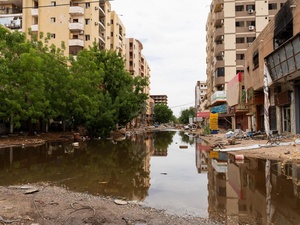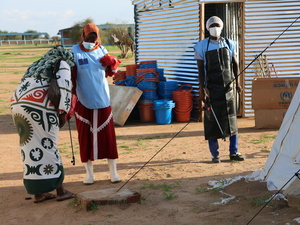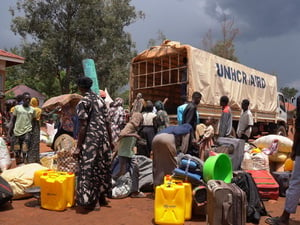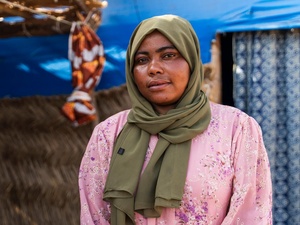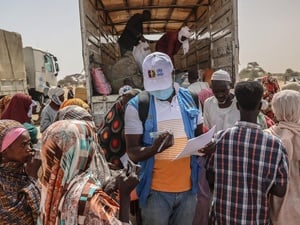Chad: Extreme concerns on Chad's capacity to sustain further influx from Darfur
Chad: Extreme concerns on Chad's capacity to sustain further influx from Darfur
UNHCR is continuing efforts to prepare for any potential new movements of refugees from Sudan's Darfur region to neighbouring Chad. But we are also extremely concerned about the capacity of eastern Chad to sustain any substantial new influx, given the chronic water shortage in an extremely arid region that already hosts some 200,000 refugees.
The last in a series of 12 UNHCR flights from Belgium is due to arrive in Chad's capital, N'Djamena, on Thursday, carrying a consignment of portable warehouses. Other contingency supplies, including blankets, buckets and plastic sheeting, were brought in on the earlier flights. This latest phase of our emergency airlift has enabled us to build up an overall contingency stock of relief items for up to 50,000 new refugees. So far this year, the UNHCR airlift has flown in some 3,250 metric tons of aid and equipment on 88 flights from 11 different countries.
Some 200,000 Sudanese refugees are currently located in eastern Chad, the vast majority of them accommodated in camps set up by UNHCR and its partners. While no significant influx has occurred in recent months, UNHCR staff across the border in Darfur report that internally displaced people there say they are considering leaving for Chad if security does not improve.
However, the general lack of water - and immense difficulties in locating new sources in this region of desert and semi-desert - continue to present a huge obstacle, both with regard to sustaining the existing refugee population in Chad and to preparing for new arrivals. The already dire water shortage in eastern Chad has been exacerbated by this year's disappointing rainy season.
UNHCR continues to pursue every avenue in its search for water, but it remains a daunting task. We're very worried that, however well supplied we may be in terms of relief items, there will simply not be enough water to supply a large number of additional refugees. Since the onset of the emergency, UNHCR and its NGO partners - especially Oxfam, Norwegian Church Aid and MSF-Netherlands - have invested considerable time, energy and money in an effort to establish reliable and sufficient water supplies for the refugee camps. Drilling equipment has been shipped in to this extremely remote region and dozens of boreholes and wells have been dug in and around the refugee camps. UNHCR water and sanitation engineers have worked alongside NGO experts to set up water bladders, tap stands and distribution systems to deliver clean water to the refugees. In some instances, we have been forced to resort to trucking water to camps from nearby villages - one of the least efficient and most expensive means of supplying water.
As part of the search for additional water resources, UNHCR has expanded a project to use remote-sensing technology, including satellite and radar images, to better understand the geology of the region and guide the more precise surveys and drilling needed to locate and develop new water sources.
The project was piloted earlier this year in a 22,500-sq-km region around Iriba town. It has now been expanded over the entire refugee-hosting region in eastern Chad, covering a total of 85,000 square km - about twice the size of Switzerland. A team is currently performing a "ground-truthing" exercise in the region to compare initial findings with final realities.
UNHCR and its partners have also deployed hydro-geologists and other experts from Australia, France, Switzerland, Germany, Kenya and the UK, who are seeking to improve our knowledge of the water situation in the area, and develop a regional approach to water management. It is hoped that this additional knowledge will also benefit local Chadian communities. The remote-sensing project, for example, has already identified a number of good water sources which, although too small to sustain a large refugee camp, could nevertheless benefit existing small local communities.
In addition to the urgent need to find new supplies, another major concern is the replenishment of the existing water sources supplying the 11 refugee camps in Chad. Massive works - and funding - would be needed for the construction of artificial barriers or small dams, if greater replenishment of groundwater were to be made possible during future rainy seasons.
Meanwhile, UNHCR is continuing to search for potential new camp sites which could serve either to decongest the existing camps or to receive any future influx of refugees. But the viability of new sites depends first and foremost on the existence of a good water supply - and the results have often proved discouraging, with many boreholes yielding insufficient quantities and a number of promising sites ultimately rejected because of the lack of water, heightening already serious concerns about the region's capacity to cope with more refugees.




